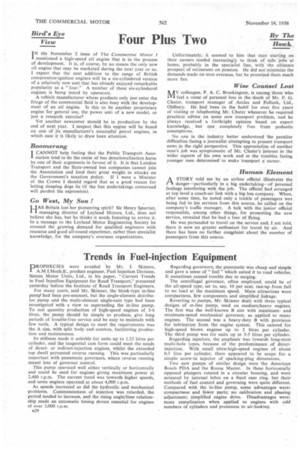Trends in Fuel-injection Equipment
Page 62

If you've noticed an error in this article please click here to report it so we can fix it.
DROPH EC I ES were avoided by Mr. J. Skinner,
A.M.I.Mech.E., product engineer, Fuel Injection Division, Simms Motor Units, Ltd., in his paper, "Current Trends in Fuel Injection Equipment for Road Transport," presented yesterday before the Institute of Road Transport Engineers.
For many years, said Mr. Skinner, the block-type in-line puma had been pre-eminent, but the single-element distributor pump and the multi-element single-cam type had been investigated with a view to superseding the in-line pump. To suit quantity production of high-speed engines of 3-6 litres, the pump should be simple to produce, give long periods of trouble-free service and be easy to maintain with few tools. A typical design to meet the requirements was the A size, with split body and carnbox, facilitating production and maintenance, Its stiffness made it suitable for units up to 1.25 litres per cylinder, and the tangential cam form could meet the needs of director indirect-injection engines, whilst the extended top dwell prevented reverse running. This was particularly important with pneumatic governors, where reverse running meant loss of governor control.
This pump operated well either vertically or horizontally and could be used for engines giving maximum power at 2,400 r.p.m. The current trend was towards higher speeds, and some engines operated at about 4,000 r.p.m.
As speeds increased so did the hydraulic and mechanical problems. Commencement of injection was retarded, the period, tended to increase, and the rising angle/time relationship made an automatic timing device essential for engines of over 3,000 r.p.m.
n28 Regarding governors, the pneumatic was cheap and simple and gave a sense of " feel " which suited it to road vehicles. It sometimes caused trouble due to surging.
The centrifugal governor, often employed, could be of the all-speed type, set to, say, 10 per cent. run-up from full to no load at the maximum speed. Main attractions were compactness, few components and simplified linkage.
Reverting to pumps, Mr. Skinner dealt with three typical designs of in-line pump, used on medium/heavy engines. The first was the well-known B size with maximumand minimum-speed mechanical governor, as applied to many engines. The second was a heavy-duty B with provision for lubrication from the engine system. This catered for high-speed blown engines up to 2 litres per cylinder. The third pump was for units up to 3-5 litres per cylinder.
Regarding injectors, the emphasis was towards long-stem multi-hole types, because of the predominance of directinjection. With small ultra-high-speed engines of about 0.5 litre per cylinder, there appeared to be scope for, a simple screw-in injector of sparking-plug dimensions.
Two new pumps of similar design were The American Bosch PDA and the Roosa Master. In these horizontally opposed plungers rotated in a circular housing, and were actuated by internal lobes on a fixed earn ring, but their methods of fuel control and governing were quite different. Compared with the in-line pump, some advantages were: compactness and fewer parts; no calibration and phasing adjustment; simplified engine drive. Disadvantages were: more complication when applied to engines with odd numbers of cylinders and proneness to air-locking.




















































































































